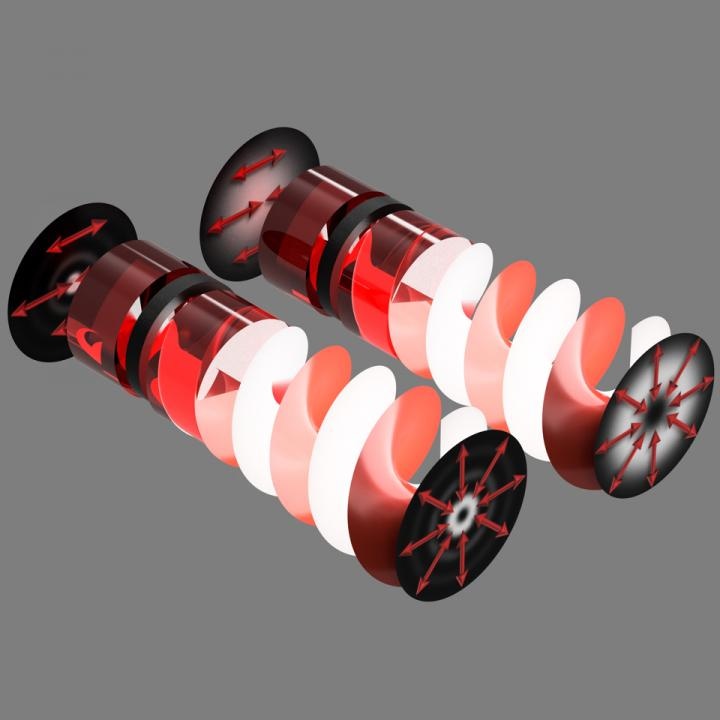Oct 31 2019
Structured light is not just a great way to elucidate patterns or pictures of light, it is the ideal way as it has the potential to power future communications that will be more secure and faster.
 This image shows the creation of hybrid entangled photons by combining polarization with a “twisted” pattern that carries orbital angular momentum. (Image credit: Andrew Forbes and Isaac Nape)
This image shows the creation of hybrid entangled photons by combining polarization with a “twisted” pattern that carries orbital angular momentum. (Image credit: Andrew Forbes and Isaac Nape)
In the last 100 years, quantum mechanics has undergone major progress. However, there is still more to achieve. In a study reported in AVS Quantum Science, from AIP Publishing, scientists from the University of Witwatersrand in South Africa analyze the advancement being made in the use of structured light in quantum protocols to develop a larger encoding alphabet, better resistance to noise, and stronger security.
What we really want is to do quantum mechanics with patterns of light. By this, we mean that light comes in a variety of patterns that can be made unique—like our faces.
Andrew Forbes, Study Author, University of Witwatersrand
As it is possible to differentiate patterns of light from one another, they can be used as a kind of alphabet. “The cool thing is that there are, in principle at least, an infinite set of patterns, so an infinite alphabet is available,” Forbes added.
Conventionally, quantum protocols have been executed using the polarization of light, which takes only two values—a two-level system that has a maximum information capacity per photon of only 1 bit. However, information capacity is considerably higher if patterns of light are used as the alphabet. Moreover, its security is more powerful, and the sturdiness against noise (for example, background light fluctuations) is enhanced.
Patterns of light are a route to what we term high-dimensional states. They’re high dimensional, because many patterns are involved in the quantum process. Unfortunately, the toolkit to manage these patterns is still underdeveloped and requires a lot of work.
Andrew Forbes, Study Author, University of Witwatersrand
In recent years, several prominent advances have been achieved by the quantum science community, both in the science and derived technologies. For instance, researchers have now demonstrated entanglement swapping using spatial modes of light, the main constituent in a quantum repeater. Also, currently, it is possible to securely communicate between nodes using high-dimensional quantum key distribution protocols.
Both possibilities together take the scientific community slightly closer to a secure and fast quantum network.
Along the same line, researchers have achieved the creation of exotic multiparty high-dimensional states for quantum computer, as well as optimized resolution in ghost imaging (generated by combining light from two light detectors). However, it is still difficult to go beyond the pervasive two photons in two dimensions to realize complete control of multiple photons entangled in high dimensions.
We know how to create and detect photons entangled in patterns. But we don’t really have good control on getting them from one point to another, because they distort in the atmosphere and in optical fiber. And we don’t really know how to efficiently extract information from them. It requires too many measurements at the moment.
Andrew Forbes, Study Author, University of Witwatersrand
Forbes and his co-author Isaac Nape helped guide the application of hybrid states—another huge progress. Old textbook quantum mechanics was done with polarization.
“It turns out that many protocols can be efficiently implemented with simpler tools by combining patterns with polarization for the best of both worlds,” stated Forbes. “Rather than two dimensions of patterns, hybrid states allow access to multidimensional states, for example, an infinite set of two-dimensional systems. This looks like a promising way forward to truly realize a quantum network based on patterns of light.”